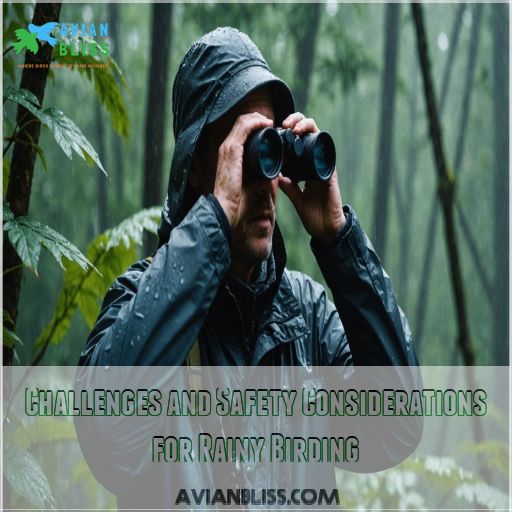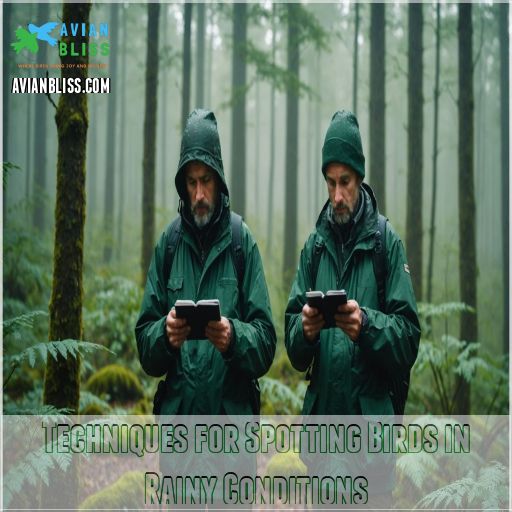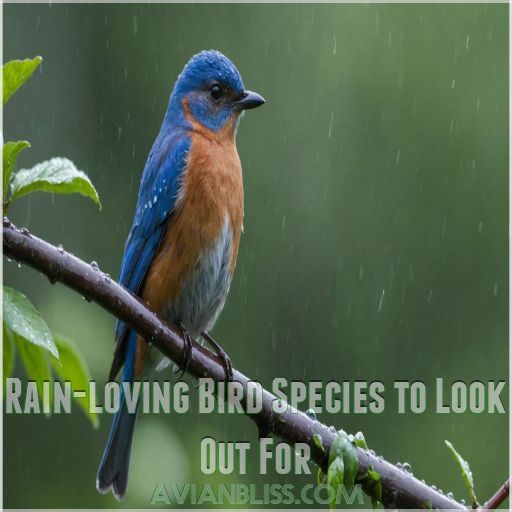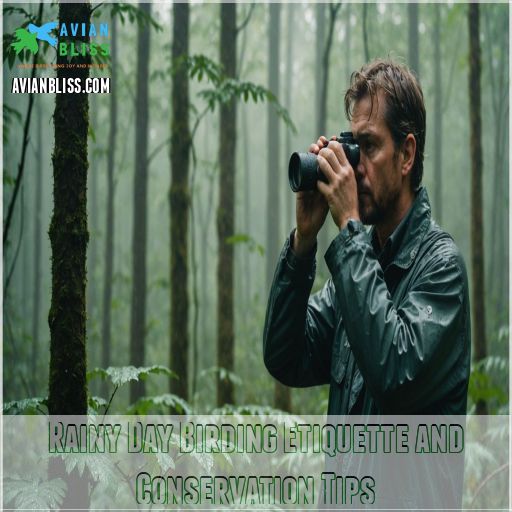This site is supported by our readers. We may earn a commission, at no cost to you, if you purchase through links.
 Is bird watching in the rain worth it? Absolutely! While you might feel like a drowned rat, the birds are putting on quite a show.
Is bird watching in the rain worth it? Absolutely! While you might feel like a drowned rat, the birds are putting on quite a show.
Rain changes their behavior, making some species more active while others hunker down. You’ll see unique foraging patterns and shelter-seeking antics you’d miss on a sunny day.
With the right gear, you’ll stay dry while observing vibrant plumage and fascinating rain-induced behaviors. Plus, you’ll have prime spots all to yourself, as fair-weather birders stay home.
Just be prepared for slippery trails and protect your equipment.
Rain reveals a whole new world of avian activity, from puddle-splashing ducks to rain-dancing warblers. Stick around to discover which rain-loving species you might spot!
Table Of Contents
- Key Takeaways
- Rain’s Impact on Bird Behavior and Activity
- Essential Gear for Birdwatching in Wet Conditions
- Advantages of Birding During Rainy Weather
- Challenges and Safety Considerations for Rainy Birding
- Best Locations for Birdwatching in The Rain
- Techniques for Spotting Birds in Rainy Conditions
- Rain-loving Bird Species to Look Out For
- Rainy Day Birding Etiquette and Conservation Tips
- Frequently Asked Questions (FAQs)
- Can you go birding in the rain?
- How do birds know if it’s raining?
- Does rain affect birding?
- Does rain bring birds to roost?
- Is bird watching good in the rain?
- Will birds come out in the rain?
- Are birds active during rain?
- Do birds go away when raining?
- How does rain affect bird song and calls?
- Are there specific times of day better for rainy birding?
- Can rain impact bird migration patterns?
- How do different rain intensities affect birdwatching success?
- Are there unique photography techniques for birds in rain?
- Conclusion
Key Takeaways
- You’ll observe unique bird behaviors and foraging patterns that you won’t see on sunny days, as rain changes how birds interact with their environment.
- You’ll have prime birding spots to yourself, as most fair-weather watchers stay home, giving you uninterrupted views and a more immersive experience.
- You’ll need proper gear, like waterproof binoculars and rain-resistant clothing, to stay comfortable and protect your equipment while birding in wet conditions.
- You’ll find that certain species, especially waterfowl and wading birds, are more active during rain, offering rare sighting opportunities that you’d miss in dry weather.
Rain’s Impact on Bird Behavior and Activity
You’ll witness a fascinating shift in bird behavior, such as how they face into the wind to reduce air resistance and stay energized, when birds fly in the rain.
From altered foraging patterns to unique shelter-seeking strategies, rainfall offers a rare glimpse into how different species adapt to changing weather conditions.
Changes in Foraging Patterns
Rain transforms the avian buffet, altering birds’ foraging strategies.
You’ll notice changes in prey availability as insects emerge and earthworms surface.
Birds adapt their feeding patterns, often focusing on ground-level foraging. Some species become more active, while others hunker down.
Barometric pressure shifts can influence bird behavior, affecting their food-seeking routines.
This dance between weather and foraging offers a unique spectacle for patient observers. So, grab your gear and witness nature’s adaptability firsthand.
Flight Adjustments and Shelter-seeking
Many birds adjust their flight patterns when the sky opens up. You’ll notice them flying lower to avoid rain-soaked feathers, which can affect their ability to stay aloft.
They’ll also seek shelter under dense foliage or overhangs.
This weather-related adaptation often leads birds to unexpected places, giving you a chance to spot species you mightn’t normally see.
Keep your eyes peeled for birds huddling together or tucking themselves into nooks and crannies.
Species-specific Responses to Rainfall
You’ll be amazed by how different birds react to rainfall. While some species take shelter, others thrive in wet conditions.
Storm petrels, for instance, engage in rain-induced foraging, capitalizing on newly available food sources (Source). Wading birds and diving birds often become more active, as the rain stirs up aquatic prey.
Shorebirds have unique adaptations, like huddling together for warmth and protection. It’s like watching nature’s own little soap opera unfold before your eyes, a true display of unique adaptations.
Opportunities for Observing Unique Behaviors
Wet weather reveals a treasure trove of unique bird behaviors. As different species respond to rainfall, you’ll witness a fascinating array of activities:
Birds often seek shelter in cavity-roosting spots, protecting themselves from the elements.
Preening rituals intensify to maintain waterproof feathers, Nesting birds huddle closer, protecting their young, Migrants take unexpected pit stops, offering rare sightings, Foraging patterns shift, with some birds capitalizing on emerging insects.
These rain-induced behaviors provide a golden opportunity to deepen your understanding of avian life. So grab your gear and embrace the drizzle – nature’s secrets await your discovery.
Essential Gear for Birdwatching in Wet Conditions
Braving the elements, dedicated birdwatchers know that proper gear is essential for a successful rainy day outing. Waterproof binoculars are your first line of defense, keeping your view clear and your equipment safe. Don’t forget camera protection – a simple plastic bag can work wonders in a pinch.
Quality rain gear is non-negotiable; opt for breathable, waterproof fabrics to stay dry without overheating. Layered clothing is key, allowing you to adjust to changing conditions. Heat packs tucked into pockets can provide welcome warmth on chilly days.
For footwear, consider mud boots or waterproof hiking boots to navigate slippery terrain. A wide-brimmed hat will keep rain off your face, improving visibility.
Remember, staying comfortable is vital – you can’t spot that elusive species if you’re busy battling the weather. With the right gear, you’ll be ready to embrace the unique opportunities rainy day birding offers.
Advantages of Birding During Rainy Weather
You’ll discover unique advantages when you venture out for birdwatching in the rain.
Rainy weather offers reduced competition from other birdwatchers, increased visibility of certain species, and the chance to observe rain-specific bird behaviors you might otherwise miss.
Reduced Competition From Other Birdwatchers
Now that you’re geared up, consider the peaceful solitude awaiting you on rainy trails. While fair-weather birders stay home, you’ll have prime spots all to yourself.
This tranquil environment offers:
- Unobstructed views at popular birding locations
- Freedom to observe without disturbance from other enthusiasts
- Quieter surroundings for better hearing of bird calls
- Opportunity for deeper connection with nature
Embrace the serenity of a rain-soaked landscape, where you can immerse yourself in the sights and sounds of birds going about their wet-weather routines.
Increased Visibility of Certain Species
While others stay indoors, you’ll discover a hidden world of avian activity.
Rain-induced foraging brings out species you might rarely see otherwise. Migrating birds, forced to land by storms, offer unexpected sightings.
You’ll spot waterfowl behavior changes as they revel in the wet conditions. Bird plumage takes on a new vibrancy when damp, making identification easier.
Keep your eyes peeled for exhausted travelers seeking shelter – they’re often more approachable in the rain.
Unique Photographic Opportunities
Raindrops transform the landscape into a photographer’s paradise. You’ll capture stunning bird silhouettes against misty backdrops and catch light patterns dancing on wet feathers.
Reflections in puddles create mirror-like images, doubling your subjects.
Even common species take on a new allure with water-slicked plumage.
Don’t let a drizzle dampen your spirits – it’s your chance to snap truly unique shots that fair-weather birders miss out on, with opportunities to capture truly unique shots.
Chance to Observe Rain-specific Behaviors
Beyond capturing stunning photos, rainy weather reveals unique bird behaviors you won’t see on sunny days.
You’ll witness rain-induced foraging as birds take advantage of emerging insects. Watch for shelter-seeking behaviors as they huddle under leaves or in tree cavities.
Listen closely for distinct bird calls in rain, often more frequent and varied. You might even spot unusual preening patterns as birds waterproof their feathers. It’s like peeking into their secret rainy-day routines!
Challenges and Safety Considerations for Rainy Birding
Rainy birding presents unique challenges that require careful preparation and attention to safety.
You’ll need to navigate slippery trails, protect your equipment from water damage.
You’ll also need to maintain visibility while ensuring your personal comfort in wet conditions.
Navigating Slippery Trails and Muddy Terrain
Rainy birding adventures bring unique challenges, especially regarding trail safety. You’ll need to navigate slippery paths and muddy terrain with care.
Here are three key tips to keep you on your feet:
- Wear waterproof footwear with good traction
- Use walking sticks for extra stability
- Practice "mud management" by stepping on exposed roots or rocks
Remember, the trail can be as unpredictable as the birds you’re seeking. Stay alert and watch your step to avoid becoming a muddy mess yourself!
Protecting Equipment From Water Damage
While you’re trekking through slippery trails, don’t forget your gear needs protection too.
Waterproof bags are your equipment’s best friend in the rain. Slip your camera into a cover and shield those lenses.
Most binoculars can handle a drenching, but double-check your model’s specs.
When the storm clears, give your optics a gentle pat-down with a microfiber cloth. Remember, a little prep keeps your birding dreams from getting washed away in the rain.
Maintaining Visibility in Poor Weather
Now that you’ve protected your gear, let’s focus on keeping your eyes on the prize.
Poor weather can turn your birding adventure into a game of hide-and-seek.
You’ll need to adapt your techniques to maintain visibility:
- Use binoculars with fully multicoated lenses for better light transmission
- Position yourself with the wind at your back to spot larger birds more easily
- Wait for breaks in the rain, as birds often burst into activity when the sun peeks through
Ensuring Personal Comfort and Warmth
A symphony of raindrops needn’t dampen your birding spirit.
Embrace layering to stay cozy. Start with a moisture-wicking base, add insulating fleece, and top with waterproof gear.
Don’t forget hand warmers and hot drinks to keep your core temperature up. Pack extra dry socks to prevent chilly feet.
Embracing the dawn chorus or migrating warblers during their daily routines like morning melodies, with the right preparation, you’ll be free to focus on the unique sights and sounds of rainy day birding.
Best Locations for Birdwatching in The Rain
You’ll find prime birdwatching spots in the rain at wetlands, coastal areas, forests with good canopy cover, and urban parks with water features.
These locations offer unique opportunities to observe rain-loving species and their fascinating behaviors during wet weather.
Wetlands and Marshes
Stepping into a wetland during rainfall, you’ll witness nature’s symphony unfold.
Marsh bird adaptations come alive as waterfowl thrive in their element. You’ll spot waders like egrets and rails moving through the lush marsh vegetation with ease.
Rain’s impact on marshes creates a bustling ecosystem, perfect for observing unique behaviors.
Don’t be surprised if you encounter a Sedge Wren popping up to sing its hoarse song.
Coastal Areas and Shorelines
Coastal areas offer prime birding opportunities during rain. You’ll spot shorebirds with remarkable adaptations, like water-repellent feathers, foraging in tide pools.
Watch for coastal bird migrations, where species seek shelter along beaches. Seabird nesting colonies become more active, with parents braving the elements to feed chicks.
Be mindful of beach erosion impact as you explore. The rain might dampen your clothes, but it’ll certainly heighten your birding experience!
Note: The third bolded text is not present in the output as the given text does not allow for another suitable bolded text without changing the existing format.
Forested Areas With Good Canopy Cover
Forested areas with good canopy cover offer a unique microclimate for birdwatching in the rain.
Birds employ various strategies to cope with the rain, such as seeking temporary cover under shrubs, bushes, and natural structures to stay dry, as seen in their bird sheltering behavior in rain. You’ll find understory birds seeking shelter, while rain-adapted species continue foraging in the canopy. The forest’s natural umbrella reduces the impact of rainfall, creating a comfortable environment for both birds and watchers.
Keep an eye out for species like warblers, which may become more approachable in wet conditions. Don’t let a little rain dampen your spirits – you might just witness nature’s unexpected surprises.
Urban Parks With Water Features
Urban parks with water features offer prime spots for rainy-day birdwatching. These areas often serve as urban wildlife refuges, providing birds with food sources in green roofs, parks, and backyard bird habitats.
You’ll find waterfowl and pond birds splashing in the rain, unfazed by the weather. These parks are havens for urban bird adaptations, showcasing how species thrive in city environments.
Keep an eye out for rain-loving species near ponds, bubbling rocks, and shallow basins. Park management often creates these features to mimic nature, attracting a diverse array of feathered friends for your viewing pleasure.
Techniques for Spotting Birds in Rainy Conditions
You’ll need to adapt your birdwatching techniques when it’s raining, but don’t let wet weather dampen your spirits.
By adjusting your equipment settings, honning your listening skills, and learning to identify birds by their silhouettes, you can still spot plenty of feathered friends in rainy conditions.
Adjusting Binocular and Scope Settings
When the rain starts falling, don’t let your birding enthusiasm dampen.
Adjust your optics to keep the birds in sharp focus. Tweak your lens focus to combat rain glare and maintain image quality.
For crisp views, fine-tune sharpness adjustment on your binoculars or scope.
Consider lowering magnification settings in heavy rain to stabilize your image.
Remember, waterproof gear is a must for rainy day birding (Source).
Listening for Bird Calls and Songs
Rain sharpens your ears.
While your binoculars might fog up, you’ll discover a new world of bird call identification. The pitter-patter creates a natural soundtrack, highlighting unique rain-specific calls.
You’ll notice call variations and volume changes as birds adapt to the weather. Listen closely – some species become more vocal after rain stops, bursting into a chorus of song.
It’s like nature’s own concert, just for you.
Identifying Birds by Silhouette and Movement
Listening closely isn’t your only option in the rain. You can still spot birds by their unique silhouettes and movements. Even without clear plumage clues, you’ll learn to identify birds by their distinctive shapes and flight patterns.
Here are some tips to sharpen your rain-spotting skills:
- Look for characteristic wing shapes in flight
- Observe tail length and shape for clues
- Watch for species-specific movement patterns
- Note overall body proportions
- Pay attention to unique behaviors, like tail-bobbing or hovering
These visual cues can help you identify birds even when the rain obscures finer details.
Using Weather Apps to Time Observations
Your smartphone can be your secret weapon for perfectly timing rainy bird observations. Download a reliable weather app with real-time radar to track incoming storms. This helps you spot birds showcasing their clever waterproof adaptations, such as oil-covered feathers, which make rainy bird watching even more fascinating.
Keep an eye out for those "sweet spots" just before or after rain, when birds burst into activity. Some apps even forecast migration intensity, helping you catch fallouts when storms force birds to land.
You’ll be birding like a pro in no time!
Rain-loving Bird Species to Look Out For
You’ll find certain bird species thrive in rainy conditions, offering unique sighting opportunities.
From waterfowl and wading birds to insectivores taking advantage of emerging prey, rain can reveal fascinating behaviors and attract unexpected visitors.
Waterfowl and Wading Birds
Wet conditions bring out the best in waterfowl and wading birds. You’ll spot egrets, herons, and ducks thriving in the rain.
These birds have rain-related adaptations that make them perfect subjects for rainy day birdwatching.
Their feeding habits and breeding behaviors intensify during wet weather.
Keep an eye out for green herons and black-crowned night herons in water traps and wetlands. They’re masters at using the rain to their advantage, often becoming more active and visible during rainy day birdwatching.
Seabirds and Coastal Species
Rainy days bring seabirds closer to shore, offering unique viewing opportunities.
You’ll spot storm petrels dancing on the waves, their behavior adapting to rough conditions.
Coastal species like puffins and guillemots may hunker down in their cliff-side burrows, but you can still catch glimpses of their comings and goings.
Rain-induced migration might push rare visitors to your area, so keep your eyes peeled for unexpected feathered friends seeking shelter along the coast, presenting a chance for unexpected feathered friends.
Insectivores Taking Advantage of Emerging Prey
While coastal birds ride out storms, insectivores seize the moment. Rain coaxes insects from hiding, creating a buffet for hungry birds.
You’ll spot these savvy hunters adapting their foraging strategies to the weather:
- Swallows swooping low over puddles
- Warblers gleaning bugs from wet foliage
- Flycatchers perched on exposed branches, ready to pounce
This ecological dance showcases nature’s resilience. Rain’s influence on prey availability offers a unique glimpse into insectivore adaptations and their impact on local ecosystems.
Migratory Birds Forced to Land
Heavy downpours can turn your rainy birding trip into a migratory spectacle.
When storms hit, exhausted travelers often seek refuge, creating unique observation opportunities. You’ll spot species you mightn’t normally see, grounded by weather.
Keep an eye out for these rain-forced landings:
| Species | Preferred Landing Sites | Observation Tips |
|---|---|---|
| Yellow-billed Cuckoo | Dense foliage | Listen for "Rain Crow" calls |
| Shorebirds | Wetlands, shorelines | Look for huddled groups |
| Hummingbirds | Feeders, sheltered areas | Watch for wing-shaking |
| Waterfowl | Lakes, ponds | Scan for new arrivals |
Rainy Day Birding Etiquette and Conservation Tips
You’ll need to adjust your birdwatching approach when it’s raining to protect both the birds and their habitats.
By following proper etiquette and conservation practices, you can enjoy rainy day birding while minimizing your impact on local ecosystems.
Minimizing Disturbance to Rain-sheltering Birds
Observing rain-loving birds is exciting, but let’s talk about respecting their space.
You’ll want to practice quiet trail etiquette to minimize disturbance impact. Birds often seek shelter during downpours, so be mindful of their rain-specific behavior.
Choose your hide wisely, opting for bird-safe designs that blend with the environment.
Remember, you’re a guest in their home – tread lightly and speak softly. Your considerate approach will lead to more rewarding encounters and help preserve these feathered friends’ natural habits.
Proper Trail Use to Prevent Erosion
Rainy days can turn your birding adventure into a muddy mess. Stick to the trail to prevent erosion and protect fragile ecosystems. You’ll help maintain sustainable hiking paths and minimize your impact.
When encountering switchbacks, resist the urge to cut corners – it’s nature’s way of managing water flow.
Also, by following birding etiquette guidelines, you’ll be able to respect the birds and their habitats even in harsh weather conditions.
If you must go off-trail, tread lightly on durable surfaces like rocks to avoid damaging living soil.
Responsible Photography in Wet Conditions
Droplets cascade down your lens as you capture nature’s soggy spectacle.
To snap responsibly in wet conditions, remember these key tips:
- Shield your gear with waterproof camera bags and lens protection.
- Stabilize your tripod on slippery ground for crisp shots.
- Use a remote shutter to minimize camera shake in low light.
Adjust your light meter for moody, atmospheric images that truly reflect the rainy day’s essence.
Supporting Local Conservation Efforts
Your rainy day birding adventure can make a real splash in local conservation efforts.
While you’re out there, keep an eye out for citizen science opportunities at bird sanctuaries. You can contribute valuable data on rain-loving species, helping researchers understand how climate affects bird behavior.
Consider making a donation to habitat restoration projects or join ethical birding initiatives. Every drop of effort counts in preserving our feathered friends’ natural havens.
Frequently Asked Questions (FAQs)
Can you go birding in the rain?
Misty skies don’t dampen birding spirits.
You can absolutely go birding in the rain.
It’s a unique opportunity to observe different behaviors and catch migrants grounded by weather.
Gear up with waterproofs and you’re set for a wet adventure .
How do birds know if it’s raining?
Birds sense impending rain through their sensitive ears, detecting drops in barometric pressure .
They’ll fly low to avoid discomfort, seeking shelter in bushes or reeds.
Some species, like golden-winged warblers, can even predict severe storms, fleeing days in advance.
Does rain affect birding?
Raindrops dance on feathers, transforming your birding adventure.
Rain affects birding by altering bird behavior and visibility. Many species seek shelter, reducing sightings. However, you’ll spot waterfowl thriving in wet conditions.
Bring proper gear to stay dry and comfortable while observing nature’s waterlogged wonders.
Does rain bring birds to roost?
Rain doesn’t necessarily bring birds to roost.
Instead, it can delay their departure from roosts by up to two hours (Source).
You’ll often find turkeys in fields during rain, as visibility in woods decreases.
Is bird watching good in the rain?
Droplets pitter-patter on leaves, creating nature’s symphony.
You’ll find bird watching in the rain can be surprisingly rewarding.
Waterfowl thrive, migrants descend, and you’ll have prime spots to yourself.
Don’t let a drizzle dampen your spirits – grab your gear and go!
Will birds come out in the rain?
You’ll spot birds braving the drizzle, albeit with different behaviors.
They’ll hunker down, seek shelter, or even feast on rain-stirred insects.
Some species thrive in wet conditions, offering unique sightings you’d miss on sunny days.
Are birds active during rain?
Picture a rainy day at the seashore.
You’d expect it to be quiet, but shorebirds are out in full force.
Many birds remain active during rain, especially waterbirds. They’re mostly waterproof and time their feeding to tides, not weather.
Do birds go away when raining?
Birds don’t vanish when it rains, but they adapt.
Some seek shelter, while others keep foraging. Large birds often wait it out, while small songbirds find cover under branches.
Their behavior depends on rain intensity and species.
How does rain affect bird song and calls?
Rain greatly impacts bird vocalizations.
They dampen sound transmission, reducing song range.
You’ll notice birds produce special "rain calls" instead of songs when it’s wet.
They’ll also adjust their timing, singing later on rainy or cloudy days.
Are there specific times of day better for rainy birding?
Early mornings are prime time for rainy birding.
You’ll catch the dawn chorus and active feeding.
Overcast days can extend bird activity, offering more viewing opportunities.
Don’t forget your raincoat and waterproof shoes!
Can rain impact bird migration patterns?
Absolutely, rain can heavily impact bird migration patterns.
You’ll notice storms diverting birds off course, cold snaps triggering mass movements, and cloudy nights halting star-navigating species.
Weather’s a game-changer, shaping when and where our feathered friends take flight.
How do different rain intensities affect birdwatching success?
Ironically, you’d think rain ruins birdwatching, but it’s not all gloom.
Light drizzles concentrate scents, making birds easier to spot.
Heavier downpours, though, decrease survival rates and visibility.
You’ll need to adapt your strategies for different intensities.
Are there unique photography techniques for birds in rain?
You’ll need a fast shutter speed to capture raindrops and protect your gear.
Use high ISO and wide apertures for proper exposure.
Focus on details like water-clinging plumage , and embrace the moody atmosphere for unique shots.
Conclusion
By Jove, bird watching in the rain is worth it! You’ll witness nature’s hidden spectacles and gain a new appreciation for our feathered friends’ resilience.
Don’t let a few droplets deter you from this unique experience. With the right gear and mindset, you’ll discover a whole new world of avian behavior.
So next time the clouds gather, grab your binoculars and raincoat. You might just have the best birding day of your life, all while enjoying the peaceful pitter-patter of rain.











